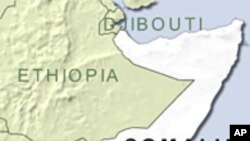The UN refugee agency reports the number of civilian casualties is rising because of the latest upsurge in fighting in the troubled South Central region of Somalia. The UNHCR says the renewed fighting is sparking a new wave of displacement.
Local humanitarian organizations in Somalia say 145 people have been killed and another 285 injured in heavy clashes in Kismayo, Beled Weyne and the capital, Mogadishu just in September.
The UN refugee agency reports former friends have become enemies. For the first time, it says clashes have erupted between al-Shabab and Hisb-ul-Islam. Until this week, it says these two Islamist groups were working together to topple the Somali government.
UNHCR spokesman, Andrej Mahecic, says al-Shabab reportedly took control of the southern city of Kismayo from their former allies on Wednesday.
"According to hospital sources, some 12 people were killed and 50 others injured," he said. "The rate of displacement of civilians within Somalia had diminished over the past two months, as compared to the months of May and June 2009, but it is still high, with 17,000 people displaced within Somalia during September alone, including 11,000 from the capital," he said.
Mahecic says fighting is continuing between government forces and Hisb-ul-Islam for control of Beled Weyne on the Somali-Ethiopia border as well as in the capital Mogadishu. He says clashes in Mogadishu have resumed between government forces and opposition groups.
"We are extremely concerned about the dire humanitarian situation of hundreds of thousands of civilians who have been displaced by the continuing conflict in Somalia," he said. "Should the fighting between al-Shabab and Hisb-ul-Islam esclate, we fear that more than half a million internally displaced people in the Afgooye corridor, some 30 kilometers south of Mogadishu, could be affected and uprooted once again. Insecurity in the Afgooye areas is already significantly limiting humanitarian access to the IDPs, but the situation could further deteriorate, making it even more difficult for Somali and international humanitarian agencies to deliver assistance to people in need."
Mahecic says the continuing fighting and displacement is causing serious repercussions in the region. He notes more than 50,000 Somalis have fled to Kenya since the beginning of the year and another 22,000 have made a perilous journey across the Gulf of Aden in rickety boats.
He says violence and the growing humanitarian crisis in Somalia are causing civilians to take desperate measures to escape.
News
Civilian Casualties Mount in Somalia

<!-- IMAGE -->








